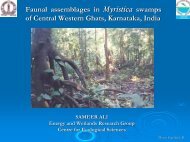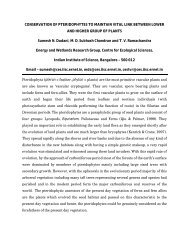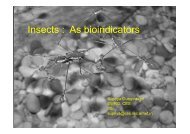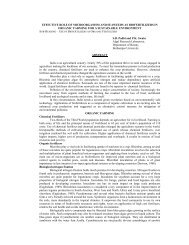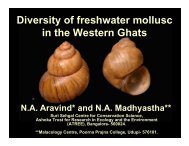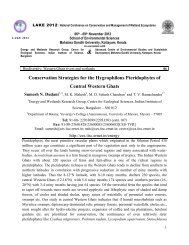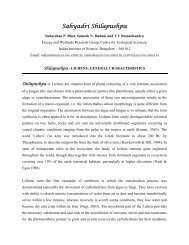a brief comp a brief comparison of modern pteridophyte arison of ...
a brief comp a brief comparison of modern pteridophyte arison of ...
a brief comp a brief comparison of modern pteridophyte arison of ...
You also want an ePaper? Increase the reach of your titles
YUMPU automatically turns print PDFs into web optimized ePapers that Google loves.
C. R. Fraser-Jenkins : A Brief Comp<strong>arison</strong> <strong>of</strong> Modern Pteridophyte Classifications (Families and Genera in India) 113<br />
structural and morphological aspects. The whole picture would undoubtedly become clearer<br />
and more refined if we could actually know which genes did what in the plants and could<br />
concentrate a new type <strong>of</strong> study more on those involved with fundamental structural changes<br />
in the origins <strong>of</strong> new groups. At present there is no guarantee that gene-sequences coding<br />
for physiological processes cannot actually arise independently on more than one occasion.<br />
Moleculologists simply do not know and cannot know for the present what sequences are<br />
relevant to what structures and merely matching sequences between plants may not<br />
necessarily indicate absolute relationships. In some ways the speed with which these studies<br />
are produced is slightly unfortunate as many appear to need further consideration and<br />
investigation - perhaps with methods yet to come. But it appears to some new authors to be<br />
easier than gradually gaining taxonomic insight and experience over a long time and is <strong>of</strong>ten<br />
the only viewpoint many workers are able to have.<br />
Some inadequacies are exemplified in one recent paper (Little & Barrington 2003)<br />
which concluded that African Polystichum forms an "African Clade" despite the fact that<br />
the genus in Africa contains at least three major and separate sections, which all have very<br />
close relations within India. Many <strong>of</strong> the papers have also been quite unable, given the<br />
methodology <strong>of</strong> working on the chloroplasts, where the genetic material is inherited only<br />
from the female ancestral species, to allow for the mixed origins <strong>of</strong> allopolyploid species.<br />
Yet they continue to include them undifferentiated in their cladology without troubling to<br />
look up what is <strong>of</strong>ten long known or suspected about their allopolyploid origin.<br />
Another aspect that requires overhauling prior to attempting to draw conclusions<br />
concerns the rate <strong>of</strong> molecular change through evolution. Sphenodon, the ancient and<br />
primitive Tuatara Lizard <strong>of</strong> New Zealand, was recently found to have a surprisingly high<br />
rate <strong>of</strong> genetic change in its DNA, but we are not therefore obliged to place it in a different<br />
genus from its structurally similar ancestors. Differential rates <strong>of</strong> evolutionary DNA change<br />
in different groups at different times, some faster, some slower, must introduce an errorfactor<br />
that becomes greater as one covers a greater time-period such as while looking at<br />
genera and families as opposed to close-knit recently evolved species-<strong>comp</strong>lexes (where<br />
molecular studies are much more obviously successful and prove reliable in elucidating the<br />
systematics <strong>of</strong> such groups). Genetic change does not necessarily go hand-in-hand with the<br />
morphological changes that can constitute different genera and families and may indeed be<br />
widely disconsolant.<br />
Because taxonomic capability, intuition and experience are not actually necessary to<br />
produce molecular-cladistic trees and then translate them directly into "taxonomic<br />
classifications", it has become the situation in parts <strong>of</strong> Asia that the workers do not<br />
themselves have a proper taxonomic background sufficient to allow a wider-based<br />
interpretation <strong>of</strong> results. They do not understand the groups they are dealing with properly<br />
and <strong>of</strong>ten cannot even identify the species properly, but any molecular similarities are<br />
immediately interpreted as being the major evolutionary factors <strong>of</strong> significance. The present



